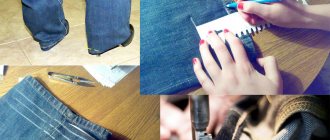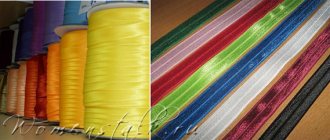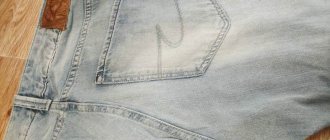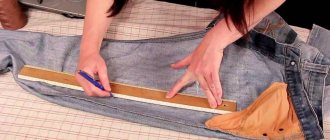When buying new jeans, many people are faced with the problem of long legs. It's rare that the length of a pair of trousers is perfect. Most people in this situation turn to the services of a tailor to sew a new item. However, you can do this work yourself. But for this it is necessary to take into account some nuances. After all, jeans have a specific color. In addition, the fabric is quite rough, which complicates the process.
The item must not lose its appearance or change its style after the manipulations. How to hem jeans correctly at home? You will learn about this from this article.
How to mark the length?
You should not measure the length using old jeans. After all, during wear, the item could become deformed. So the length of her pants may vary.
- Pair your new jeans with shoes and a belt.
- Look at yourself in the mirror from the side.
- Fold the jeans inside and pin the hem.
The length of medium-wide trousers should reach the heel. Skinny jeans should be leveled above it. Flared jeans should cover half the heel.
Bolognese jacket repair
Despite the widespread use of this material for the manufacture of outerwear, these jackets cannot be called durable. A small snag can instantly turn into a hole with jagged, jagged edges. But such damage can be eliminated using two methods.
Method 1 using a fabric patch
To disguise such a hole, you need to make a patch from two pieces of bologna fabric. Before use, these pieces must be degreased with acetone and allowed to dry. One is glued from the inside to the damaged area. The other closes the hole from the outside. It should be slightly larger than the hole itself. Use clear, moisture-resistant fabric adhesive following the instructions.
After drying in place, the patches are made into a patch, choosing the appropriate color and texture. You can also use thermal decal.
Method 2: use polyethylene or non-woven fabric
A bolone jacket can also be repaired using another method. If the cut itself is smooth, and if damaged, there is a piece of fabric left from this clothing, you can connect the edges using non-woven fabric. This is a dry adhesive. You need to apply it using gauze and an iron.
A piece of bologna is sewn to the non-woven tape. It is glued to the inside of the jacket with a hot iron. From the outside, the edges of the hole must be connected evenly. If desired, you can also use an applique.
If you need to disguise a tear quickly, and you don’t have tape with dry glue on hand, you can use cellophane. The effect of polyethylene is similar to non-woven fabric.
To repair such damage, you need to prepare:
- scissors;
- glue;
- cotton pads;
- iron;
- gauze cloth;
- material for patches, appliqués;
- sharp blade;
- heavy object for the press;
- polyethylene or strips with non-woven fabric.
On a sewing machine
To get a beautiful seam, it is advisable to choose thicker threads of the appropriate shade. How to hem jeans using a machine:
- Determine the length of the hem and leave an allowance of 2 cm.
- Iron the seams and secure everything with pins.
- Open the reverse stitch from the wrong side of the fabric.
- Pull out the decorative seam.
- From the wrong side, sew a new seam.
If the trouser fabric is thin and the hem is small, you can shorten the jeans without cutting the fabric. You just need to fold the excess inward and make a seam.
If the fabric is dense or has decorative abrasions, the work should be done differently. First you need to bend and shorten the trouser legs with an allowance of 3.5 cm. After this, you need to smooth the allowances in different directions and overcast them by hand. The factory hem needs to be folded, basted and sewn on a typewriter.
To better understand how to sew jeans on a sewing machine, watch this video.
Required tools and materials
The decorative seam along the bottom of the legs serves as decoration for the jeans, so when shortening you want to preserve the finish. Before work, you need to remember that an incorrectly measured length of 1-2 cm can disrupt the style of the trousers. To accurately hem jeans, you will need the following tools and materials:
- sewing machine for stitching on thick fabric;
- needles for processing denim material;
- measuring tape, chalk (soap marker);
- tailor's scissors or regular ones with a sharp edge;
- pins, thick threads to match the stitching of the pants;
- threads to match the color of the jeans for unnoticeable hemming.
Experts recommend measuring strictly along the right leg. Then you should carefully align the jeans - lay the item on a flat table surface, fold it inside with the legs, align it along the side seams, belt line, pockets and inner seam. There should be no folds or distortions on the fabric.
How to cut jeans correctly and not disturb the decorative appearance of the bottom of the trousers: first, try on the jeans, mark the hem and tuck them, and try them on again with the shoes. Then the right trouser leg is trimmed, the fitting is performed again and the left trouser leg is shortened. Before making a machine seam, the hem line is basted with contrasting threads.
Preserving the factory seam
The option of preserving the factory seam is suitable for those who do not want to cut the trouser legs. After all, it’s not so easy to shorten pants. If you are off by a couple of centimeters, the item will no longer fit well. Sometimes the bottom edge of the jeans is frayed, so a new seam can change the appearance of the product for the worse.
Some fabrics contain synthetic fibers and may shrink. If you don't trim the legs, you can always undo the stitching and make the legs longer.
Instructions:
- Find out how much fabric needs to be trimmed. To do this, put on jeans and fold the edge of the legs to the desired length. Pin the fold with a needle. Measure the length of the hem using a ruler.
- Remove the jeans and turn them inside out. Using a ruler, measure the required number of cm from the edge of the factory seam.
- Make an indent of approximately 5 cm and again set aside the desired length from the factory seam. Connect the resulting dots. Work both legs in this manner.
- Fold your pants inward. At the same time, connect the drawn line with the upper border of the factory hem.
- Connect the side seams and pin them with a pin. Pin the fabric in a few more places.
- Turn your jeans inside out. Join with a backstitch to the factory seam.
- Iron the seams and folds thoroughly. Secure the fold with a blind stitch.
It is recommended to make the seam with an indentation of 1.5-2 millimeters from the factory hem. In this case, it will straighten out easily.
If you need to shorten pants with fringe running along the bottom, hemming while preserving the decorative decoration will not look very nice. In this case, you will need to make a new decorative decoration yourself. First measure the length of the hem. Please note that fringe will increase the length of the legs. Using a thick needle or nail scissors, begin to pull out the cross threads. You will create an interesting decor. You can stitch over the fringe, this will prevent the threads from unraveling further.
Finishing fabric edges: what is it for?
Processing the edge of the fabric is a mandatory process before the main work. It allows you to preserve the cut of the material, the transverse threads not to crumble, and not to deform the appearance of the future product.
Some novice needlewomen do not want to spend time processing the edge, believing that this is not at all necessary. But practice shows that in the end they often end up with a low-quality product with frayed edges and damaged embroidery.
The tension of the fabric during work stretches the canvas, the stitches may differ in size and look sloppy. Therefore, experienced craftswomen must process the cuts before starting work.
How to hem jeans by hand
You can shorten the legs without cutting the bottom with your own hands without a machine. This method is especially suitable for girls who often change their shoes. If you want to wear high-heeled jeans with shoes without them, you can quickly shorten them.
- Determine which part of the legs you need to trim and draw a line with tailor's chalk.
- Iron the hem on the wrong side.
- Turn your pants inside out. Using small stitches, sew the bottom of the jeans to the side seams.
This hem is temporary. It can be easily removed. This method comes in handy in situations where an item needs to be quickly adjusted to length.
Preparing to Hem Jeans
It is worth noting that without much effort or equipment you can shorten and hem medium-weight denim and thin materials.
Jeans made from thick fabrics can cause problems. In this case, it is more advisable to immediately contact a studio that has professional sewing equipment.
Immediately before performing the operation, you need to determine the required length of the trousers. Moreover, for female models it may be more difficult to determine this indicator than for male ones.
To find out the required length of jeans, you need to put on your shoes and stand up. Then a mark is placed, based on which all further manipulations will be carried out.
Men most often wear shoes with flat soles or low heels. Women often exchange sneakers for shoes with a high bobbin and vice versa. Accordingly, the required length of trousers will be different for each case. However, the shortened models that are fashionable today are much easier to hem.
It is better to measure length individually for each leg, since almost every person has some physiological asymmetry. Pants should be quite comfortable both when wearing and sitting.
The fastest way
If you need to quickly shorten your jeans, but don't have a sewing machine and don't want to make the seam yourself, you can use this method. The materials you will need are an iron and Moment glue.
- Measure the required length of jeans and trim off any excess fabric.
- Using glue, secure the seam allowance along the fold line and run an iron along it.
- Glue the folded edge in the same way.
The result may not look very nice. But if you have no other way to shorten your jeans, then this method is quite suitable.
Instead of glue, you can use adhesive tape.
The operating principle will be the same:
- Remove the factory seam, it will create unnecessary irregularities.
- Mark the fold line.
- Apply adhesive tape to the wrong side.
- Iron the product along the bottom.
What to do?
Don't let the lack of an overlocker bother you. You can sew the overlock stitch by hand. It's not as difficult as it might seem at first glance. Of course, you will have to spend much more time, but the result may look very decent in appearance.
What is an overcast stitch? We use it for finishing fabrics during the sewing process. At the same time, they can be used to fasten individual panels. Thanks to this, you can get a very neat tissue cut. There are several ways to make an overcast seam by hand. And in our article we will try to touch on some of the subtleties of this work.
The photo below demonstrates quite clearly what a hand-made overcast seam looks like in a product.
Blind seam
You can hem jeans at home using a hidden seam. It is made using vertical stitches.
- Insert the needle into the fold and then remove it.
- Pick up 2 or 3 strands of fabric.
- Insert the needle into the beginning of the stitch in the fold and bring it out from the left side at a distance of 5-7 millimeters.
- Carry out manipulations alternately on the main fabric and the fold fabric.
The thread should be in one addition. Only in this case the seam will be invisible.
Crocheting the edge of the product.
This method of edge processing is most often used for knitted items. But whoever owns a crochet hook can use it for both knitted materials and fabrics. This single crochet stitch is clean, stretchy, and looks beautiful.
It is also important that when tying, the edge involuntarily bends slightly to the wrong side and therefore the stitching becomes even cleaner
In this article we looked at ways to finish edges by hand.
In conclusion, I will say about threads. For sewing sections, the threads are selected in color. Thick threads can not only look rough, but when ironing they can be pressed onto the front side by the iron. However, thin threads also cover the edge poorly, making it more difficult to make an even and beautiful stitch. Ideally, it is better to use darning thread to sew the edges of the product by hand. They are soft, loose, and cover the edge well. They do not experience tensile loads, so they can be safely used.
Write which of the manual methods of processing sections did you like best?
I look forward to your comments and questions. If the article was useful, share it with friends, like, subscribe and receive the book “Sewing Machine for Home Use” as a gift.
With love, Olga Zlobina
Stitch seam
It is very convenient to shorten jeans using a sewn seam. How to do this correctly?
The stitch seam is made without gaps. The needle is inserted into the exit of the previous stitch. The direction of the seam is from right to left. The thread should be in the middle.
- Insert the needle to the right of the thread at a distance of 5 millimeters.
- On the left, bring it out at the same distance. You will get a beautiful stitch.
- After this, insert the needle into the beginning of the stitch. Output 5 millimeters to the left of the thread.
Basic rules for hand stitches
Hand seams have a structure that consists of the following elements:
- stitch – 1 completed cycle of thread weaving;
- line - a sequence of stitches:
- Stitch pitch is the distance between 2 needle punctures.
To ensure that hand stitches are smooth and neat, you need to follow some rules:
- Carry out work on a flat, well-lit surface. This will reduce eye strain and allow you to control the tension of fabrics and threads.
- It is recommended to use a thimble when sewing. This will protect your fingers from punctures, preserve your nails and speed up your work.
- To obtain an even stitch, tighten the thread, controlling its tension.
Hemming with trimming
This option is ideal for thick denim. After all, folds can be difficult to sew even using a sewing machine. It will also help out when you need to fold a very large amount of fabric.
It is better to wash your pants before cutting. This way you will avoid troubles associated with fabric shrinkage. Here are the step-by-step instructions:
- Measure the fabric to be trimmed. Put on your trousers and roll them up to the desired length. Pin the folds using pins. Measure the length of the hem.
- Turn the trousers inside out and set aside the required length from the edge. Indent to the side and make a line. Connect the dots with a line. On the other side, make a line at the same level.
- Step back 3 cm from the drawn line. Make marks and draw another line that will be parallel to the previous one.
- Trim along the bottom edge of the leg. Fold 1 cm upward, to the middle between the marked line and the end of the leg. After this, make a 2 cm hem and connect the fold with a line.
- Sew the jeans using a backstitch or machine stitch. Iron.
When cutting jeans, the factory seams will be broken. They need to be carefully joined so that the stitches match and the side seam does not move. This is worth taking into account so that you don’t have to do everything all over again.
Where are hand stitches used?
There are more than 20 types of hand stitches. Their names and areas of application depend on the direction of the stitch on the fabric. Stitches can run in a straight line, diagonally, crosswise and in the form of loops.
The following table shows the classification of the main hand stitches:
| Stitch type | The seam |
| Straight |
|
| Oblique |
|
| Cross-shaped |
|
| Loop-shaped |
|
| Looped |
|
| Special |
|
The use of all the variety of stitches comes down to several areas of application:
- temporary hemming and stitching of parts, copying of stitching lines;
- decorative finishing;
- processing the edges of products using overcasting or hemming;
- connecting parts with permanent stitching using invisible and decorative seams.
Hemming using trouser tape
Buy trouser tape that has a suitable shade.
Cotton tape may shrink a lot after washing. Therefore, it is recommended to wash and dry it before use.
- Put on your jeans and measure the length you need.
- Use chalk to draw a shortening line. Set aside 2 cm and 1.5 cm from it. Draw a new line.
- Trim off any excess fabric. At the same time, leave an allowance of 3.5 cm.
- Baste the trouser tape to the bottom of the trouser legs. The thicker edge of the tape should match the edge of the pants.
- Sew the braid using parallel stitches.
- Iron the seam allowance up.
- Make another line on the wrong side. Thread a blue thread into the needle. The finishing thread, which is thicker, should be in the bobbin.
Due to the trouser braid, the edge of the legs will become tighter. Jeans will be worn for a long time and will not fray.
Let's get started
So, you and I don’t have an overlocker. Before making an overcast seam by hand, let's estimate our resources. Let's take the highest quality needles, preferably from a well-known manufacturer. It is best if it is a needle with a special coating in the area of the hole, in this case called the “golden eye”. Thanks to it, the thread will be easy to thread and slide smoothly through the fabric.
The numbering of needles used for hand sewing ranges from 1st to 12th number. What do these numbers mean? This is a tenfold increase in its largest diameter in millimeters.
Never use a needle for work if it is dull, bent or rusty. And do not forget about matching the thickness of it and the thread. After all, the larger the diameter of the needle, the greater the force required to push it through the fabric. Accordingly, the thread must be thick enough.
How to sew jeans at the waist
It's rare that the trousers you buy fit perfectly. Often they have to be sutured at the waist. This is where rubber bands come to the rescue.
- Measure your waist length from the back side, subtract 10 cm. You will get the length of the elastic band. Let's say the back length at the waist is 35 cm, which means you need an elastic band 25 cm long.
- On the wrong side of the trousers, leave an equal amount of space on both sides of the side seam. This distance should correspond to the length of the elastic band.
- At the ends of the segments, make cuts with scissors no more than 3 centimeters wide.
- Attach a pin to the end of the elastic. Pull the elastic from one end to the other.
- Pin one end of the elastic, then put on your pants and set the tension you need.
- Attach both ends to the hole using a needle back stitch.
The cuts can be finished with a buttonhole stitch. This will prevent the threads from fraying. Stitches should be made vertically.
Where is it used?
A blind seam by hand (photos are presented step by step later in the article) is easy to do. It has several purposes. The main function is to connect two parts.
The main uses of a blind seam are described in the table:
| Where is it used? | Blind seam type |
| Clothes repair (suturing rips, cuts, loose seams) | Facial connecting |
| Making toys (sewing parts of arms, legs, heads, ears, stitching seams) | Facial connecting |
| Hemming bottoms (jeans, trousers, skirts, blouses) | Purl hem |
| Making clothes (sewing sleeves, lining) | Facial connecting |
| Manufacturing of products using patchwork and quilling techniques (folding the edges of the product, processing decorative elements) | Purl hem |
Repairing a burnt hole
A hole in clothing may appear from touching a hot object. For such damage, jacket patches are suitable. They can be selected taking into account the material and color of the outerwear.
How to sew up a hole if the hole is large?
Repair of such damage is most often carried out in the studio. But you can cope with this unpleasant situation on your own. Now there are many applications and accessories for decoration.
Initially, you need to decide on the style in which the damaged item will be transformed. The large hole is first sewn up, and then various decorations are used to disguise the damage site.











